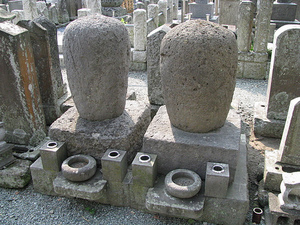Difference between revisions of "Masamune"
| (3 intermediate revisions by the same user not shown) | |||
| Line 6: | Line 6: | ||
Masamune is among the most famous of Japanese swordsmiths. Originally from [[Sagami province]], he lived in the late [[Kamakura period]] (c. late 13th to early 14th century). | Masamune is among the most famous of Japanese swordsmiths. Originally from [[Sagami province]], he lived in the late [[Kamakura period]] (c. late 13th to early 14th century). | ||
| − | Masamune was the apprentice or student of [[Shintogo Kunimitsu|Shintôgo Kunimitsu]]<!--新藤五国光-->, and is said to have been adopted by [[Soshu Yukimitsu|Sôshû Yukimitsu]], another of Kunimitsu's students. | + | Masamune was the apprentice or student of [[Shintogo Kunimitsu|Shintôgo Kunimitsu]]<!--新藤五国光-->, and is said to have been adopted by [[Soshu Yukimitsu|Sôshû Yukimitsu]], another of Kunimitsu's students. Yukimitsu is also considered the second-generation master of the [[Soshu school|Sôshû school]] of swordsmiths.<ref>"Soshu Yukimitsu, Sword Blade," gallery labels, LACMA.[https://www.flickr.com/photos/toranosuke/16314786572/sizes/h/]</ref> |
| − | Early on, Masamune mimicked the distinctive tempering pattern of Kunimitsu's blades, a style known as Sôshûmono after Sagami province (''Sôshû'') where they were made, and perfected or completed that style. After developing his own style, he passed it on to his son [[Sadamune]], who went on to become a significant swordsmith in his own right. | + | Early on, Masamune mimicked the distinctive tempering pattern of Kunimitsu's blades, a style known as Sôshûmono after Sagami province (''Sôshû'') where they were made, and perfected or completed that style. After developing his own style, he passed it on to his son [[Soshu Sadamune|Sadamune]], who went on to become a significant swordsmith in his own right. |
Several of Masamune's blades are today considered [[National Treasures]]; these have names such as "Kanze Masamune" and "Hôchô Masamune." Most of his swords, however, bear no inscription. Only four ''[[tanto|tantô]]'' by Masamune which feature markings are extant. These are known as "[[Fudo|Fudô]] Masamune," "[[Daikoku]] Masamune," "Kyôgoku Masamune," and "Honsô Masamune." | Several of Masamune's blades are today considered [[National Treasures]]; these have names such as "Kanze Masamune" and "Hôchô Masamune." Most of his swords, however, bear no inscription. Only four ''[[tanto|tantô]]'' by Masamune which feature markings are extant. These are known as "[[Fudo|Fudô]] Masamune," "[[Daikoku]] Masamune," "Kyôgoku Masamune," and "Honsô Masamune." | ||
| Line 19: | Line 19: | ||
*"[http://www.kamakura-burabura.com/jinbutum.htm#masamune Kamakura no rekishi-jô no jinbutsu]." Kamakura-burabura.com 鎌倉ぶらぶら. | *"[http://www.kamakura-burabura.com/jinbutum.htm#masamune Kamakura no rekishi-jô no jinbutsu]." Kamakura-burabura.com 鎌倉ぶらぶら. | ||
*"[http://kotobank.jp/word/%E6%AD%A3%E5%AE%97 Masamune]." ''Asahi Nihon rekishi jinbutsu jiten''. Asahi Shimbun Co. | *"[http://kotobank.jp/word/%E6%AD%A3%E5%AE%97 Masamune]." ''Asahi Nihon rekishi jinbutsu jiten''. Asahi Shimbun Co. | ||
| + | <references/> | ||
[[Category:Kamakura Period]] | [[Category:Kamakura Period]] | ||
[[Category:Artists and Artisans]] | [[Category:Artists and Artisans]] | ||
Latest revision as of 13:07, 2 December 2016

- Japanese: 正宗 (Masamune)
- For other people by this name, see Date Masamune or Hirata Masamune.
Masamune is among the most famous of Japanese swordsmiths. Originally from Sagami province, he lived in the late Kamakura period (c. late 13th to early 14th century).
Masamune was the apprentice or student of Shintôgo Kunimitsu, and is said to have been adopted by Sôshû Yukimitsu, another of Kunimitsu's students. Yukimitsu is also considered the second-generation master of the Sôshû school of swordsmiths.[1]
Early on, Masamune mimicked the distinctive tempering pattern of Kunimitsu's blades, a style known as Sôshûmono after Sagami province (Sôshû) where they were made, and perfected or completed that style. After developing his own style, he passed it on to his son Sadamune, who went on to become a significant swordsmith in his own right.
Several of Masamune's blades are today considered National Treasures; these have names such as "Kanze Masamune" and "Hôchô Masamune." Most of his swords, however, bear no inscription. Only four tantô by Masamune which feature markings are extant. These are known as "Fudô Masamune," "Daikoku Masamune," "Kyôgoku Masamune," and "Honsô Masamune."
Though today often referred to as the greatest master of all Japanese master swordsmiths, it was not until the Azuchi-Momoyama period (late 16th century), when Toyotomi Hideyoshi made a habit of giving Masamune blades as formal gifts, that he came to be regarded as such.
Masamune is buried at Hongaku-ji, a temple in Kamakura. In addition to a rounded gravestone over the presumed site of his actual grave, a monument in his honor stands near the entrance to the temple's cemetery.
References
- "Kamakura no rekishi-jô no jinbutsu." Kamakura-burabura.com 鎌倉ぶらぶら.
- "Masamune." Asahi Nihon rekishi jinbutsu jiten. Asahi Shimbun Co.